|

COVER STORY | IN
THE NEWS | STAGE
MATTERS | OFF
THE PAVEMENT
BOOKNOTES | TALK OF THE TABLE | THE HUM | CALENDAR
November 23, 2006
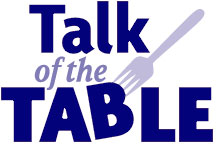
Food: the tie that binds
by JUDY
HODGSON
"What is it with this
family? How come all our gatherings, every time we get together,
it's all about food? We are obsessed. It's all we talk about!
When we finish one meal, we're planning the next. Even our vacations
are all about food!"
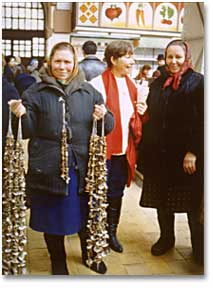 That
statement was shrieked in my direction once, years ago, by one
of our grown daughters, who shall remain nameless because ...
well, she was on a diet and none too happy about it. And she
was exaggerating. But just a little. That
statement was shrieked in my direction once, years ago, by one
of our grown daughters, who shall remain nameless because ...
well, she was on a diet and none too happy about it. And she
was exaggerating. But just a little.
Then, one night last week, my husband said "Remember
that Utah trip we took? What's-her-name, our niece ... that soup
she made after skiing?"
That Utah trip was in the late '80s or early '90s,
at least 15 years ago, and I knew exactly the soup he was talking
about tortilla soup with an entire bar loaded with toppings ready
to pile into our steaming bowls. Shredded chicken, cilantro,
homemade crispy tortillas and lime wedges to squeeze on top.
It was fantastic. And her name is Jennifer, I reminded him, not
for the first time. Spain? We remember that trip because of the
fried calamari sandwiches and olives in the tapas bars. Mexico?
Shrimp, margaritas and piles of guacamole. We eat guacamole every
day we're there because the buttery perfect Haas avocadoes are
about 10 cents apiece.
Left and below: A trip to the former Soviet
Union in the early spring of 1988 was a grim food experience
until the tour group traveled south to Kiev in the Ukraine. The
open markets there were bountiful with fresh meat, dried nuts,
dates, plump apricots and babunyas (grandmothers) offering dried
mushrooms on a string.
I am writing this before Thanksgiving and no, I'm
not going to give you my family recipe for turkey tetrazzini.
But I did want to write about families, and family gatherings,
and, well ... food.
Like the music we listen to and the books we read,
food is such a strong part of our culture. It's who we are. I
was raised in Los Angeles in the '50s by my mother, the daughter
of Russian immigrants. My father died when I was young and we
had no nearby family on that branch of the tree. So my brothers,
sisters and I had my mother and her mother my babunya, the one
who taught me when you are cutting vegetables for borscht all
the little pieces had to be the same size because if they were
irregular or big, you were a sloppy cook. Except the potatoes,
which as everyone knows are peeled and cooked whole in the broth,
removed, mashed and then added back to thicken the borscht.
Shashlik (lemon-onion marinated lamb kebobs)
and vareniki (dumplings filled with egg and hoop cheese)
are part of my food DNA. But I'm also an L.A. kid, so I love
chorizo and scrambled eggs for breakfast, and what all in our
family affectionately call McGirk Street tacos, made by my mother
who often sent me to the corner store to buy fresh corn tortillas,
still warm and sold by the kilo.
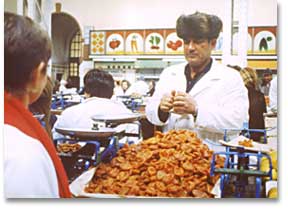 I
was prompted to write this family/food story by an article I
read recently by Anne Raver first published in the New York
Times and then last Saturday in the San Francisco Chronicle.
She wrote about how she had hired a live-in caretaker for her
93-year-old mother who still insisted on living alone. The caretaker
assumed many of the duties this feisty woman had previously done
for herself, like making her own morning coffee and other cooking
chores. Eventually, Raver wrote, her mother "lost her joie
de vivre. She spoke in a whisper when I came by to chat,
and she didn't have much to say. `Everything is fine,' she said
with a thin smile." Long story short, the aide eventually
left and her mother perked right up, resuming her own cooking
chores and regaining her independence with all the enthusiasm
of a 16-year-old who just passed her driver's test. I
was prompted to write this family/food story by an article I
read recently by Anne Raver first published in the New York
Times and then last Saturday in the San Francisco Chronicle.
She wrote about how she had hired a live-in caretaker for her
93-year-old mother who still insisted on living alone. The caretaker
assumed many of the duties this feisty woman had previously done
for herself, like making her own morning coffee and other cooking
chores. Eventually, Raver wrote, her mother "lost her joie
de vivre. She spoke in a whisper when I came by to chat,
and she didn't have much to say. `Everything is fine,' she said
with a thin smile." Long story short, the aide eventually
left and her mother perked right up, resuming her own cooking
chores and regaining her independence with all the enthusiasm
of a 16-year-old who just passed her driver's test.
I knew exactly what Raver was talking about. In
2000, my own mother moved from her home in Big Bear (in the mountains
east of Los Angeles) to live with my husband and me in Fieldbrook.
At the time she was recovering from heart surgery and pretty
run down, but eventually she bounced back. The three of us became
good roommates and all shared cooking duties. My mother took
over all the shopping chores and you would often see her tooling
around town in her little red Nissan. She would wander the Co-op
aisles for hours "because they sell so many interesting
things." After four years, however, she bought herself a
little mobile home in McKinleyville and moved out, cheerfully
telling everyone she was divorcing us. She missed her independence.
As long as she was healthy enough, she wanted to be on her own
like she was for the previous 18 years, ever since she lost my
stepdad.
One of those independent things she missed was
cooking all her own meals yes, three times day and eating exactly
what she wanted when she wanted it. She always ate dinner at
6 p.m., not 8 p.m., as we preferred. When my husband cooks, he
doesn't particularly care if you think something is weird, or
if you like it. The important thing is he likes it. For instance,
he makes a smoky, grilled radicchio salad sprinkled with corn
kernels and straight radicchio that's not exactly for everyone's
palate. My mother, however, tended to choose food to please 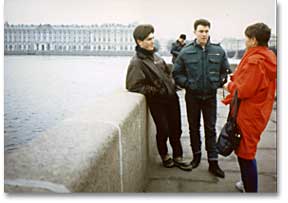 others,
her roomies, when it was her turn to cook. I noticed that when
she was back on her own turf, however, out came a lot of the
old recipes. She made akroshka, a cold buttermilk, cucumber
and egg soup. Or stewed tomatoes, not a big favorite of mine.
Some nights she just ate leftover lima bean casserole if she
felt like it. And she made borscht again, happily sharing it
with neighbors since it's impossible to make a small quantity
of borscht. others,
her roomies, when it was her turn to cook. I noticed that when
she was back on her own turf, however, out came a lot of the
old recipes. She made akroshka, a cold buttermilk, cucumber
and egg soup. Or stewed tomatoes, not a big favorite of mine.
Some nights she just ate leftover lima bean casserole if she
felt like it. And she made borscht again, happily sharing it
with neighbors since it's impossible to make a small quantity
of borscht.
Left: The author's mother, Holly Gubrud, spoke
fluent Russian to students in St. Petersburg, eager to learn
of news from outside the Soviet Union. the building in the background
is the Hermitage.
I would often stop by on my way to work and she
would offer me coffee perked in her old aluminum pot or some
tea. On my way home, we often shared a glass of wine and nibbled
on pistachios, Brio bread and olive oil, a daily habit she acquired
when she lived with us. I would sit and watch her cook her early
dinner and we would talk about family history past and present,
trips we'd taken together and yes, food.
In 1988, the two of us took a journey of a lifetime
together to Russia (then the Soviet Union). Since she did not
speak English until she went to kindergarten in Los Angeles,
her language skills quickly returned and she was my interpreter.
It allowed us incredible freedom to go anywhere and mingle with
ordinary people. Instead of the hotel dining rooms frequented
by our American tour partners, we ate where the Russians ate,
often in cafeterias. The food was mostly grim and not the Russian
food of my childhood. As we traveled from St. Petersburg to Novgorod
to Moscow, we noticed there was one cheese a rubbery tasteless
white blob in the entire country. It was very early spring, so
there were no fresh vegetables or fruit. Cafeteria, by the way,
was a misnomer. There was often no choice involved. At one place
we ate steaming bowls of broth with dumplings the only selection.
We were going to have tea, but at the end of the line I saw something
from my childhood and busted out laughing. It was prune juice.
Not the stuff we find in a bottle at Safeway. My family made
prune juice from dried prunes boiled in sugar water and lemon.
It was served with a plump prune in the bottom of the glass.
Wherever we traveled, we shared tables with people, told our
stories and listened to theirs.
The food improved as we traveled south to Kiev,
where they told us they were not Russians, they were Ukraines,
and they certainly knew how to eat. At the open markets, we feasted
on nuts and dried apricots and watched the butchers practice
their art. (My mother, several uncles and cousins were all butchers
in L.A.) We were supposed to travel south all the way to Yerevan
(in the Caucasus Mountains) where my family originally came from,
but that leg of the trip was canceled due to civil unrest. I'm
sure the food there would have been even better.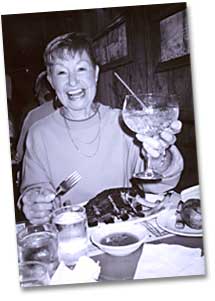
Last Thanksgiving, my mother (pictured at right)
was briefly in the hospital and then, with the help of Hospice
(a story for another day), I took her home to McKinleyville.
She died Dec. 15 at age 85. So in her honor, here's one of her
recipes when you get tired of leftover turkey. My No. 2 son-in-law
Phil, who loves peasant food, thinks I'm a genius when I cook
it.
Cut the core out of a head of cabbage, put the
head in a deep bowl and pour boiling water over it to wilt the
leaves. Mix a stuffing of ground lamb, finely chopped onions,
salt, pepper, lots of dill weed and a handful of uncooked rice.
(Russians don't measure.) Cut the tough rib end from each cabbage
leaf so they will roll easily. And here's the secret: put a pitted
prune in the center of each meat roll. Place the rolls in a deep,
heavy pot, cover with water and canned tomatoes. Top with quartered
carrots and potatoes and any leftover cabbage, more salt, pepper
and dill, and simmer on a low flame, slowly for a very long time,
at least an hour. Top the rolls with sour cream, a staple in
every Russian's refrigerator.
Even my grandchildren will eat these cabbage rolls
(except the one who sneakily peels off the cabbage and pushes
it to the side of his plate). I just tell them there's a secret
inside each roll. It was a family secret, now it's yours.

your
Talk of the Table comments, recipes and ideas to Bob Doran.
COVER STORY | IN
THE NEWS | STAGE
MATTERS | OFF
THE PAVEMENT
BOOKNOTES | TALK OF THE TABLE | THE HUM | CALENDAR
Comments? Write a
letter!

© Copyright 2006, North Coast Journal,
Inc.
|